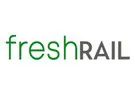"An average freight train can replace 56 trucks," reads the Prorail website. After walking and cycling, trains produce the least CO2 emissions of all transportation forms. Yet in 2021 - the European Year of Rail - only 11% of all goods were transported by rail in Europe. That would be different, were it up to Fred Lessing, Director of Intermodal Solutions at FreshRail. This Dutch company focuses on greening fresh logistics by facilitating the modal shift to rail. While he sees many opportunities in rail freight transport, Fred also notes some obstacles that must be overcome.
"A modal shift is vital for transportation’s carbon footprint. Once you choose rail - over longer distances, that is - then, aside from the costs, you reduce CO2 emissions by 70 to 90%," he begins. Cost-wise, too, if a company truly commits, Fred sees a 20-30% savings opportunity and room for further CO2 emission reductions. For example, at the recent Agri & Food Logistics Congress, he shared that in many projects set up by FreshRail, the ultimate goal is to achieve zero emissions. The target is to have 80% of transport done via rail, with trucks used for the remaining 20%. "That's to ensure the trains are always full and that, with the trucks, you can offer volume flexibility with a truck."
Break-even from 700 km
Nonetheless, rail is not the preferred choice for freight transport. One of the stumbling blocks Fred sees here is the break-even point, which is currently around 700 kilometers. That long distance has to do with how rail transport is set up. He points out that this mode of transport is often either a company train that runs exclusively for one customer. Or a terminal-to-terminal route, where companies must independently complete the trip up to and from those points.
And that costs money. Lessing distinguishes between actual rail transport and pre and post-hauls. "At maybe €0.50/km, rail transport is cheaper than road transport. But there's also the before and after route, which, besides trucks, involves shunting the train on a siding. Often another locomotive must be used to reach the terminal, which is far pricier per kilometer than regular, long-distance locomotives," he says.
Hub could be a solution
So, for now, shorter distances cost more. That challenge must still be overcome. "Everyone wants green transport, but not at extra costs." Fred sees creating a terminal hub which could include a distribution center, as a possible solution to make rail freight transport more profitable. "Then those 700 kilometers would immediately become a few hundred shorter. Once you rearrange the logistics, that can happen quickly," he continues.
"We want Rotterdam to function as a hub where transport streams from across Europe can merge to then go in different directions, fully loaded." Fred compares it to the road transportation hub function that already exists in the Netherlands.
Customized fruit and vegetable connection
A hub could make rail transport even more effective, and for that, FreshRail has a site at the Port of Rotterdam in mind. Fred says customized connections could be possible from there. He considers the lack thereof another stumbling block, especially regarding fruit and vegetables. "Most current train connections aren't made for fruits and vegetables. Those have different departures and arrival times, with undesirable lead times and reliability. Ultimately you want to create something specifically for these products."
Even lacking that customized connection, FreshRail is arranging rail freight for a Scandinavian retailer. According to the director, it is not yet perfect. "It takes a day longer, or it's not what the customer wants," he admits. Still, the retailer is committed to rail transport. "They want to show their clients they're working on this. They've even had stickers saying 'I took the train' made that they put on fruit, for example.'" Fred notes that customers are eager but that rail is a complex transportation mode and, to ensure reliability, must be set up properly.
Trains could be faster than trucks
FreshRail notes that people often think trains are slower than trucks. That need not be so, says Fred, but then legislation has to change. "Currently, freight trains must stop for other trains, especially passenger trains. For a passenger train to go two to three minutes faster, freight trains could sacrifice a few hours, which slows them down tremendously. If you're transporting fruits and vegetables, you should have priority. If that were to change, a train would be faster than a truck with two drivers. That could be the difference. It could be cheaper and faster. Then, the world would look very different in a few years," he concludes.
For more information: 
Mark Remie
FreshRail
Tel.: +31 06 29 57 72 04
[email protected]
